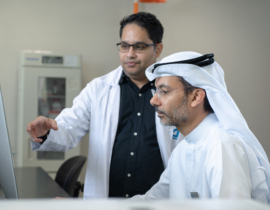Scientists from MBRU and Al Jalila Children’s find possible genetic links to rare life-threatening complication of COVID-19 in children
Equipped with genetic and clinical data of dozens of Arab children in Dubai and Jordan, a new study led by scientists from the Mohammed Bin Rashid University of Medicine and Health Sciences (MBRU) and Al Jalila Children’s Hospital points to novel genetic factors that may contribute to multisystem inflammatory syndrome in children (MIS-C), a rare but life-threatening complication of COVID-19 in children.
MIS-C is a rare but serious complication that may occur in children with COVID-19. The condition is characterized by intense inflammation (cytokine storm) and can affect multiple organs including the heart, lungs, kidneys, brain, skin, eyes, or gastrointestinal organs. MIS-C is a life-threatening disease if not diagnosed and treated promptly. It is not clear why certain children develop this complication, and the recent study provides new evidence on the potential genetic factors related to MIS-C.
The study analyzed clinical, laboratory markers, and genomic findings of 70 predominantly Middle Eastern children who had COVID-19, of whom 45 met the case definition of MIS-C while 25 did not and were included as ‘controls’. Patients were treated at Al Jalila Children’s Specialty Hospital in the UAE as well as in the Jordan University Hospital between September 2020 and August 2021.
Funded by the Al Jalila Foundation and published in JAMA Network Open, the study found that children with MIS-C were significantly more likely to have rare and likely damaging immune-related genetic changes when compared to control children with COVID-19 but without MIS-C. Furthermore, there was an association between genetic findings and disease onset and resistance to treatment.
“This is an important study not only because the findings show comprehensive genetic profiling of children with MIS-C which is essential to characterize the genetic contribution to the disease, but also because patients of an Arab background have long been underrepresented in genetic studies,” said Dr. Walid Abuhammour, Head of the Pediatric Infectious Diseases department at Al Jalila Children’s Specialty Hospital, and study investigator.
The study was the result of multi-institutional collaboration among Dubai-based scientists from MBRU, Al Jalila Children’s Specialty Hospital, the Medical Education and Research Department and the Pathology Department at Dubai Health Authority, as well as colleagues from the University of Jordan and The Specialty Hospital’s department of Pediatrics in Jordan.
“With all entities of the Dubai Academic Health Corporation involved, this study demonstrates the vision of the Corporation to foster collaboration and drive excellence in clinical care and discovery. This work represents a template for future high-quality research that will have a global positive impact on patients, as attested to by the publication of the findings in a highly respected scientific journal” said Professor Suleiman Al-Hammadi, Dean of the College of Medicine at MBRU.
“This study provided Dubai Academic Health Corporation researchers with an opportunity to be involved in collaborative research which involved multiple researchers from different institutions and organizations. Collaborative research is always encouraged as it has many benefits which include developing new research skills, strengthening partnerships and building research capacity in healthcare organizations,” said Dr. Hamda Hassan Khansaheb, Head of Medical Research at Medical Education and Research Department, Dubai Health Authority.
“The results of this research suggest that rare genetic factors play a role in MIS-C disease and highlight immune-related pathways which might become targets for intervention,” said Ahmad Abou Tayoun, Director of Al Jalila Children’s Genomics Center and Associate Professor of Genetics at MBRU.
“Hopefully, this will now prompt additional studies to functionally characterize some of the identified genes, and to expand genomic sequencing to more diverse populations to fully characterize the genetic landscape of this new disease entity” Dr. Abou Tayoun added.
The study results are available here.


